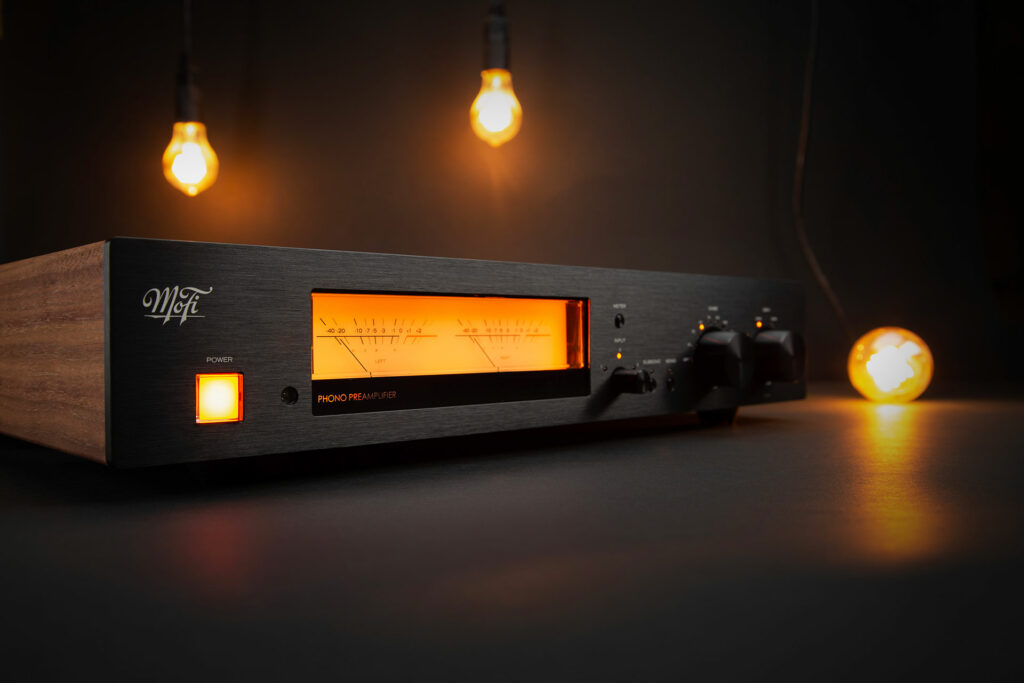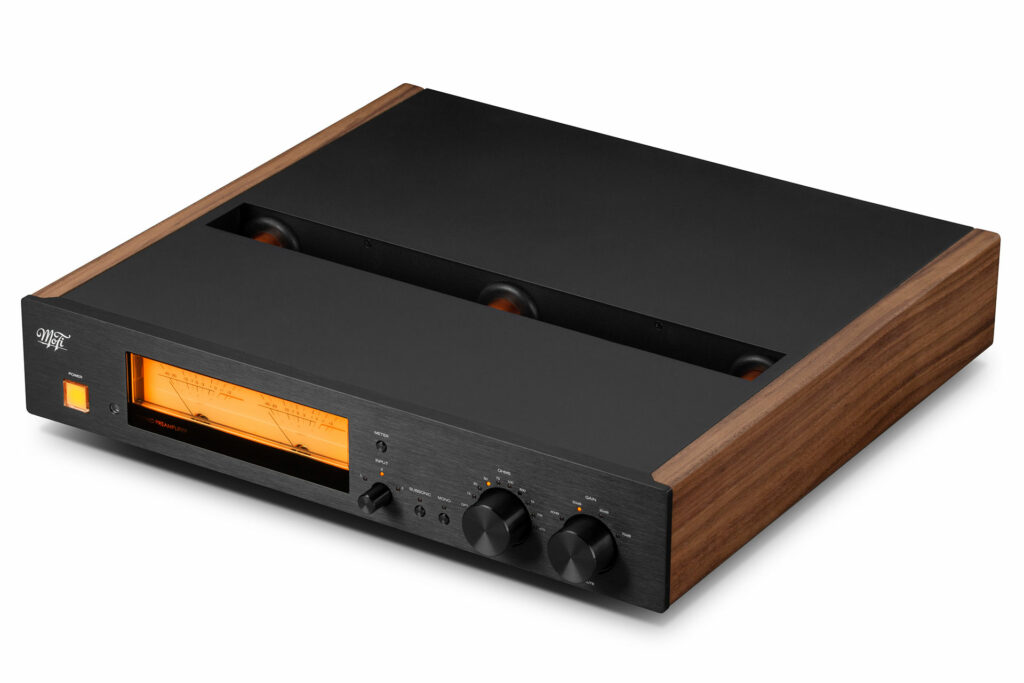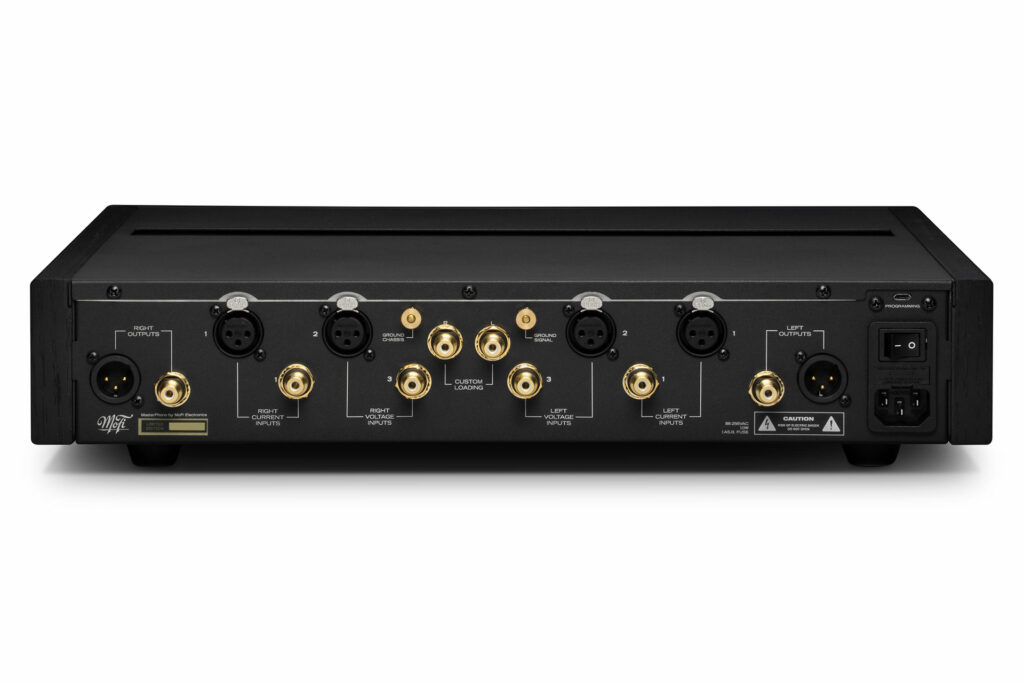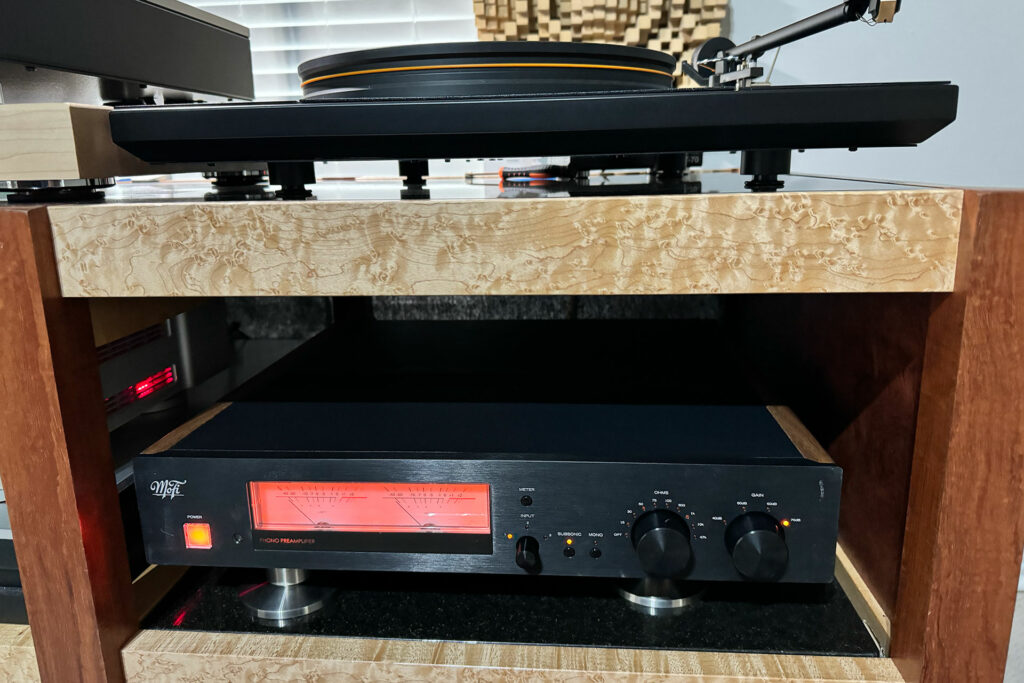Founded in 1977, Mobile Fidelity Sound Lab, better known today as MoFi, has been a leader in producing high quality, remastered, specially plated and pressed versions of previously released LPs. In the late 1980s, they added uniquely remastered Compact Discs to their catalog of excellent-sounding music software.
In 2016, MoFi decided it was time to enter the electronics business in the form of turntables, phonostages, phono cartridges, speakers and accessories, all designed by industry-leading veterans. To differentiate this branch from their record label, they call themselves MoFi Electronics. When it came to a top-level phonostage, MoFi reached out to longtime designer Peter Madnick, who is widely known for his affiliation with Constellation and Audio Alchemy. Madnick was given the charge of developing a feature-packed phonostage in the $6,000 price class.

What Makes the MoFi Masterphono Phonostage Special?
- Perhaps most readily noticeable are the two separate chasses in one enclosure. This design feature provides a separate enclosure in the front for the power supply and microprocessor. The rear chassis contains the low-voltage signal processors and related electronics. These two completely separate compartments are connected by three copper tubes, through which various cables are routed. This rather ingenious design provides galvanic isolation through separate enclosures, without the increased costs associated with having two completely separate boxes. From the front, the MoFi Masterphono looks like one device. From the top, the two compartments are easily identified. This configuration claims to provide an exceptionally quiet operation and a superb signal-to-noise ratio.
- Moving Coil (MC) with very low output impedance (10 Ohms or less) will perform their best when connected to a Current Input on the rear of the unit.
- Madnick very ingeniously provided a solution to low-output Moving Coil cartridges. Anyone with such a cartridge knows the difficulty in achieving normal amplitude without all manner of hum and background noise. Masterphono features a Trans-Impedance, Dynamic-Loading Voltage Input connection, both RCA and XLR, designed for low-output voltage and impedance MC cartridges, which normally require significant gain and high-impedance settings. Using this connection bypasses the normal resistor impedance control; instead, the load is automatically optimized by the circuit itself. For those, like me, with a low-output MC cartridge, this connection method was a veritable salvation, and gave me any amplitude level I wanted with no hum. Ultimately, it’s not about gain, but about the cartridge being able to look into a load that looks like a virtual short circuit, allowing it to supply more current than voltage.
- Four switchable adjustments of 40dB, 50dB, 60dB and 70dB provide a sufficient range of gain settings.
- There are 10 switchable impedance adjustments on the front panel including an optional load that selects a set of RCA jacks on the back to which one plugs their resistor of choice which has been soldered to a male RCA plug.
- The dual front meters are entertaining to watch as music plays, but they also serve another function. They can be switched to “Meter Mode,” where the meters may be used for azimuth adjustment when setting up a cartridge and tonearm.
- Fully discrete circuitry is used from input to output, with the highest quality parts available.
- Passive RIAA equalization using film and foil capacitors and critical resistors provide close tolerance filtering and equalization curves.
- Both balanced and single-ended inputs and outputs are supported.
- A remote is included to power the unit on and off, turn the LED lamps on the display on and off, mute the output, and make adjustments to the gain and load settings.
Why Should You Care About the MoFi Masterphono Phonostage?
With modern audio systems, any number of options exist to enable playing an LP. In the phonostage world, there are capable components for less than $1,000. In fact, MoFi has two such options. For those systems with gear that is slightly above a very inexpensive entry-level price point, this phonostage is a standout. Given the dual chassis in one enclosure architecture, the multiple input options, the ability to use balanced and single-ended cables, the fact the unit may be used for cartridge setup procedures, and having all these features at a price of $5,995, this phonostage might actually be considered a real-world value. Can you spend more on a phonostage? Yes, easily so. Nagra has one for over $87,000, if you are so inclined. Finding one with these features and build quality packed into a $5,995 price is not such an easy task. For these reasons alone, the MoFi Masterphono is a product worthy of consideration for those who are well-invested in the vinyl part of this hobby.

Some Things You Might Not Like About the MoFi Masterphono
- I found the user instructions to be a little thin. In many cases, they only offered a bare minimum of information on how something works. I like to see a very detailed list of instructions on operational procedures, with full explanations of features and benefits. There are also some additional instructions on the MoFi website. Personally, however, I would prefer everything in one detailed brochure included in the shipping box.
- I noticed a slight background noise that I suspected was being caused by the electronics passing vibrations through the signal path as distortion. In my audio room closet, I have a number of anti-vibrational devices not currently in use. I found four Stillpoints Ultra SS with Base I wasn’t using and, when I placed them under the Masterphono, the noise essentially disappeared; I was left with a much blacker and more silent background. As such, I would like to see a better type of footer on the unit.
- This is very likely not a big deal to most, but I always prefer an option of both a black and a silver front faceplate. MoFi does have two finishes for the wooden sides of the component, but only black for the faceplate. In my rack, the sides of the unit are not visible, so the finish on the wood is almost irrelevant. What I see is the front and, since almost my entire system is silver, I’d like to see that option for consistency. I will agree, however, that the wooden sides on my review sample look very nice.
Listening With the MoFi Masterphono Phonostage
I am always impressed with any component displaying a mostly neutral portrayal of the musical presentation. The MoFi Masterphono excelled in neutrality, while at the same time delivering a sometimes sterile, sometimes warmer character across a wide variety of LPs, essentially always rendering the sound that was on the actual LP. Using two different MC cartridges, one a Ortofon MC Verismo and the other a MoFi Ultragold MC, I was easily able to distinguish what each cartridge did well with the MoFi Masterphono in my reference system. The character of each cartridge was easily discernable with the sound pouring forth from my speakers was fun, lively, dynamic where necessary, other times soft and modest, and always, in my estimation, true to the recording. Whichever iteration was used, the sound pouring forth from my speakers was fun, lively, dynamic where necessary, other times soft and modest, and always, in my estimation, true to the recording. That the MoFi Masterphono was able to be so versatile is very likely one of its best features.
Recorded in 1971, when they were arguably at the zenith of their professional career, The Allman Brothers Live at the Gilmore East is my favorite ABB recording. Central to that is the 13-plus-minute recording of “In Memory of Elizabeth Reed.” Written by guitarist Dickey Betts, this song brilliantly exemplifies Southern Rock and the Allman Brothers Band in ways perhaps few of their other works can. Duane Allman’s guitar and brother Gregg’s organ work play off each other throughout almost the entire song. With the Masterphono at the helm, this track had nearly visceral dynamics when the guitar was really wailing and separate and apart from that were Gregg Allman’s keyboards. Drums were concussive, and the bass line was clear and easily followed. There was little in the way of surface noise on the LP and, as such, the clarity was exceptional. I’ve been listening to this song for about 40 years, and each time I play it on my system, I am reminded why I like it so much. The engaging and entertaining quality brought about by the MoFi Masterphono made this track very enjoyable and one I will play again – probably very soon.
Depending on your point of view, or which version of history is more believable, “Money For Nothing” from the iconic audiophile album Brothers in Arms by Dire Straits is either a testament by Mark Knopfler about how much he hated the newly-formed cable channel MTV, or how much he enjoyed it considering the money that he made from it. Regardless, the opening minute or so, with that almost haunting falsetto “I Want My MTV” refrain lofting around in the background, gives way to a commanding drum track with sufficient clarity to allow hearing the individual drum strikes. When Knopfler’s axe kicks in, well, let the air guitar fun begin. This is one of the most iconic guitar riffs ever played. With the dynamic intensity perpetrated by the MoFi Masterphono, this remastered LP sounded quite powerful. At about the two-minute mark, drums and guitar are going full tilt and, I must say, given the presentation put forth by the MoFi Masterphono, I was tempted to jump up and let loose with a little air guitar myself. I have not listened to this LP in several years and doing so for this review, and the enjoyment I took from the effort, made what was once an overplayed nightmare into an LP I really enjoyed.
Does the MoFi Masterphono Have Any Resale Value?
In preparing this review, I looked online for a used Masterphono and could not find one for sale. I saw various MoFi electronics devices offered, mostly turntables and speakers, but not one of these phonostages.
This might be because the device is only a few years old, or maybe because owners have not yet seen fit to part with the one they are using. Whatever the reason, there does not seem to be a wealth of available MoFi Masterphono phonostages on the used market. This would suggest the resale value, if a used model may even be found for sale, is excellent. It also suggests these components will be used for many years before being replaced.

Who Is the Competition for the MoFi Masterphono?
Pass Labs has two audiophile phonostages, one just below the price of the Masterphono and one above. And yes, they have the XS model for $38,000, but I’m not considering that one a competitor, due to cost. The Pass Labs XP-17, at $4,500 (read the review), is a popular unit, with excellent build quality, and a worthy contender to the MoFi Masterphono. It has up to 72dB of gain to help support low-output cartridges, can accept MC and MM cartridges, multiple inputs and a variety of load settings. The Pass Labs XP-17 has also been designed with extra filtering to reduce noise and provide an excellent signal-to-noise ratio. If you have a little extra budget, you might also look at the Pass Labs XP-27 which is a more expensive, two-chassis
For those who prefer tubed equipment, or at least a hybrid tube/solid state design, there is the VTL TP 2.5i at a retail cost of $6,000. Like the MoFi Masterphono, the VTL TP 2.5i also features passive RIAA Equalization and a number of impedance settings. However, the VTL 2.5i has only two MC gain settings of 56dB and 62dB, which means low-output MC cartridges may not have sufficient amplitude unless a step-up transformer is used.
Publisher’s Note: MoFi Electronics doesn’t recommend plugging a step-up transformer into the current input.

Final Thoughts on the MoFi Masterphono
I really put this phonostage through the mill. I used two turntables, two cartridges, three different power cords, two different interconnects and four different tonearm cables. With my low-output Ortofon MC Verismo cartridge I used the Current Input with the gain set to 70dB and , I tried the Voltage Input, which is designed for low-output cartridges. I also used the Current Input with the gain set to 70dB. And lastly, I tried the Voltage Input, which is designed for low-output cartridges. In each configuration, the MoFi Masterphono performed beyond my expectations and provided me with all the amplitude I wanted, with no noticeable hum or similar effects. The MoFi Ultradeck turntable with the MoFi Ultragold cartridge also performed exceptionally well. A review on Future Audiophile for this turntable is forthcoming.
I was especially impressed with the Masterphono’s ability to use the meters in a calibration mode. A cartridge setup test record and the meters make setting the azimuth much easier and more accurate than doing so by eyesight.
Most importantly, I was captivated with the sound this phonostage rendered. Despite using multiple turntables, cartridges and cables, when the needle dropped, I was immediately impressed with the sonics of any LP I decided to play. I listened for hours and, surprisingly, didn’t seem to mind the laborious task of flipping the album every 20 or so minutes. I played everything from LPs that somehow managed to survive my 1970s college dorm room days, all the way to six MoFi Ultradisc One Step exceptionally high-quality LPs, and in every case, I loved what I heard. Music with the MoFi Masterphono sounded lively, engaging, made me tap my toes and listen to a greater number of LPs than normal.
Initially, I had no preconceived notions about this phonostage. What I immediately discovered was the very impressive features of the Masterphono and, better still, the level of sonics it helped provide to my system’s analog section. What Peter Madnick and MoFi have created is a phonostage that punches well above its (already heavy) weight class. Given cost relative to features and the sonics it can create, the MoFi Masterphono is a an inherently smart value. In very simple, very succinct terms, listening to an LP with the MoFi Masterphono was thoroughly engaging and entertaining – much more so than I ever expected. It rendered a completely captivating sound and had no issues grappling with all types of LPs at all levels of quality. Unlike some phonostages I have used in the past, the MoFi Masterphono made LPs sound lively and fun – a veritable toe-tapping, head-bobbing enterprise. I would not hesitate to recommend a thorough audition of this phonostage to anyone interested in a component at this level of cost. Because, in all fairness, the MoFi Masterphono is simply a well-designed and exceptional phonostage.




Yours is one of the first reviews of this component in existence (Fremer did one a few months ago), and there are no reviews of the MasterDeck yet, so it’s probably going to be a year or two before we see them on the resale market. Engineering and materials aside, the price point is curious. It’s low when the market for phono stages that support multiple arms and relatively exotic low-output cartridges is considered. If you have a rig with multiple turntables/tonearms and high-dollar, esoteric MC carts then $6K may seem like a no-brainer. Then again, listeners who have invested tens of thousands in tables, tonearms and carts (and cables) may be skeptical of a unit at this price point.
It’s a high-dollar product when viewed from the perspective of a more modest analog setup, however. My phono stage cost $2K and I’m quite happy with it. Jumping up to $6K would only be worth it for me if I had also upgraded my turntable from a VPI Classic to a model that accepts multiple arms, and had also acquired carts that required the current-mode amplification. That’s quite a bit of outlay before the feature set of this product becomes fully useful. I’m also concerned to hear about spurious noise in a product where the bill of material went way up to support a dual-chassis configuration. In any event, I hope it’s a successful product as it’s great to see MoFi supporting the engineers designing their products!
Caleb, first, thanks for a well reasoned comment. Thanks also for responding to my review! Along with the MasterPhono, MoFi also sent the UltraDeck with the UltraGold cartridge factory mounted. They also sent the StudioSilver cartridge as a lower cost option. Those products will be in a forthcoming review. Granted, not the MasterDeck but something in the same family anyway.
Your issues regarding pricing are well founded. And while this phonostage does not support any turntable with multiple arms, phonostages that do are typically quite a bit more than this one. For my system, given the cost of the turntable, cartridge, and the various cables, the $5995 retail price for the MasterPhono is very much in line. As always, it makes sense to have components in the same general area of price and performance. Any system whose TT, cartridge and assorted cables are far less or much greater in general cost, this phonostage may not be the right one. Would it still do a really great job? Probably so. You pointed this out also and I agree with your assessment.
As to the issue of noise, I firmly believe in footer devices and platforms designed to reduce vibrational energy. In fact, every single component in my system, including my speakers has something designed for this purpose. In this case, they happened to make a difference. On a different system, maybe not. My opinion about the use of a footer is mine alone but I felt like it was worth pointing out what I discovered.
Again, thanks for your reply. Happy Listening!
Paul
The prices of components have risen to atmospheric levels. I am using an Ayre K1xe mp with built in phono…..I wouldn’t expect this 6000 dollars would be any better than the wonderful sound I’m getting …yes it’s old, but has never given any problem..only gorgeous airy 3 dimensional sound…only music…no hum, noise, etc.